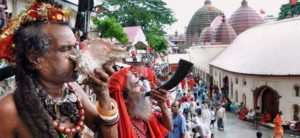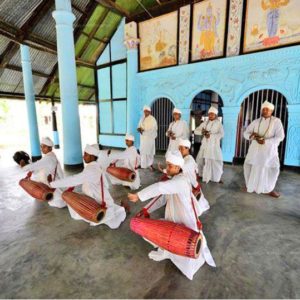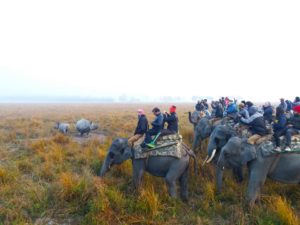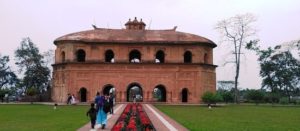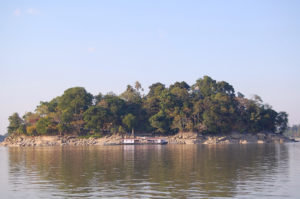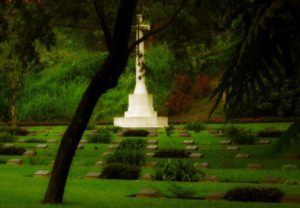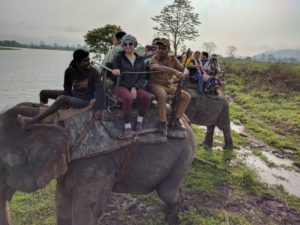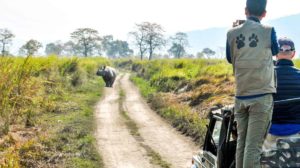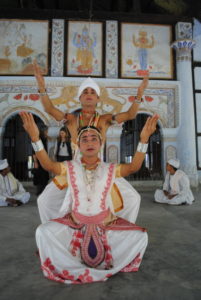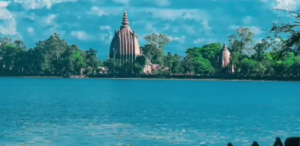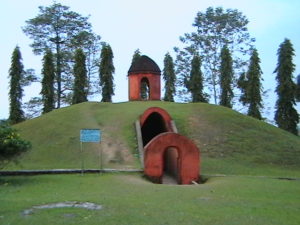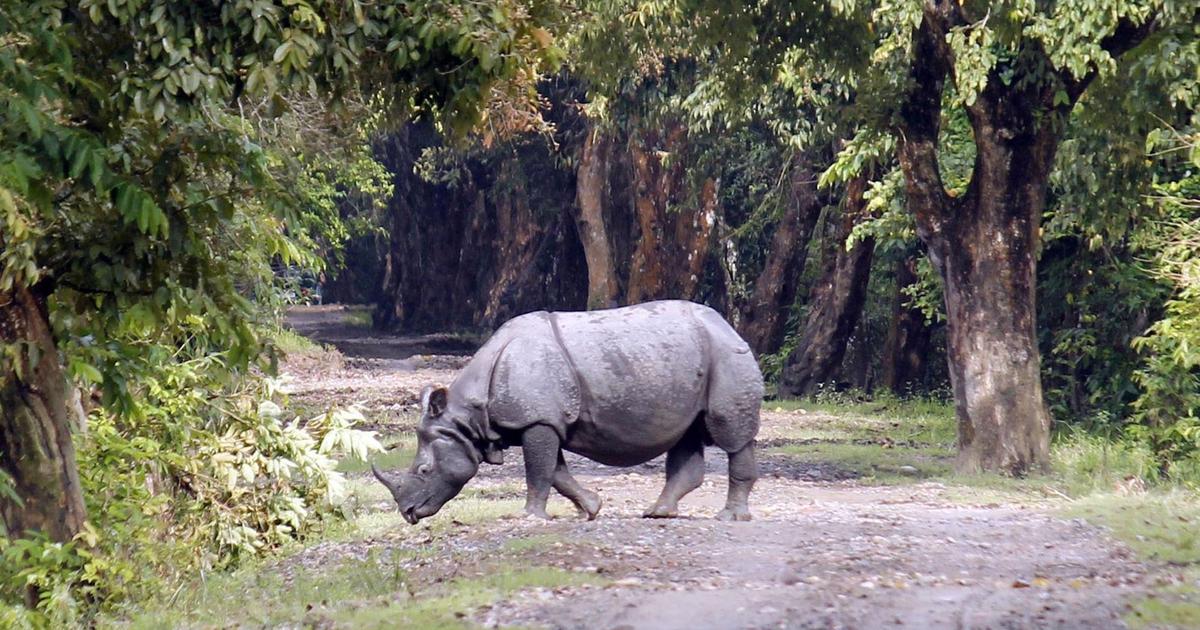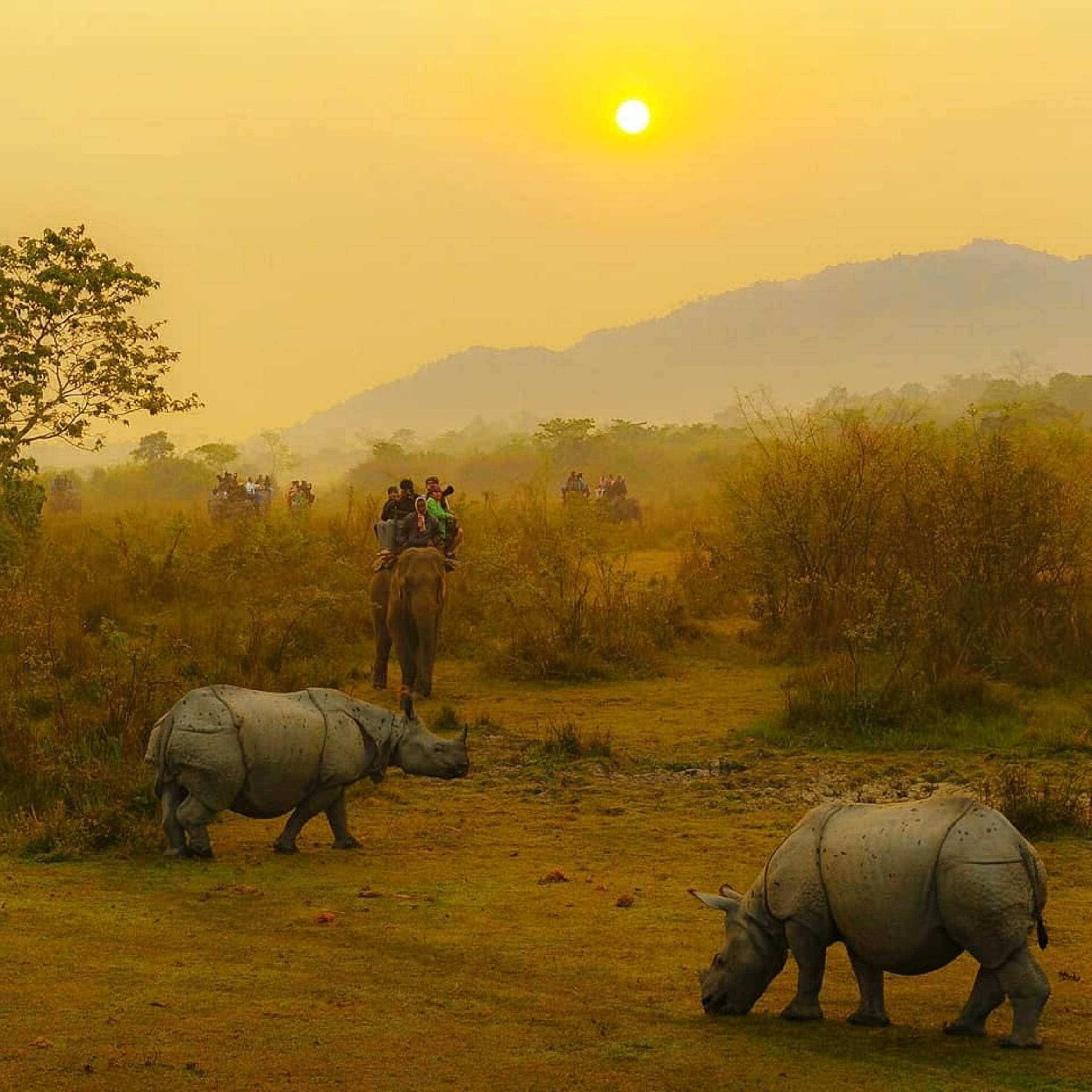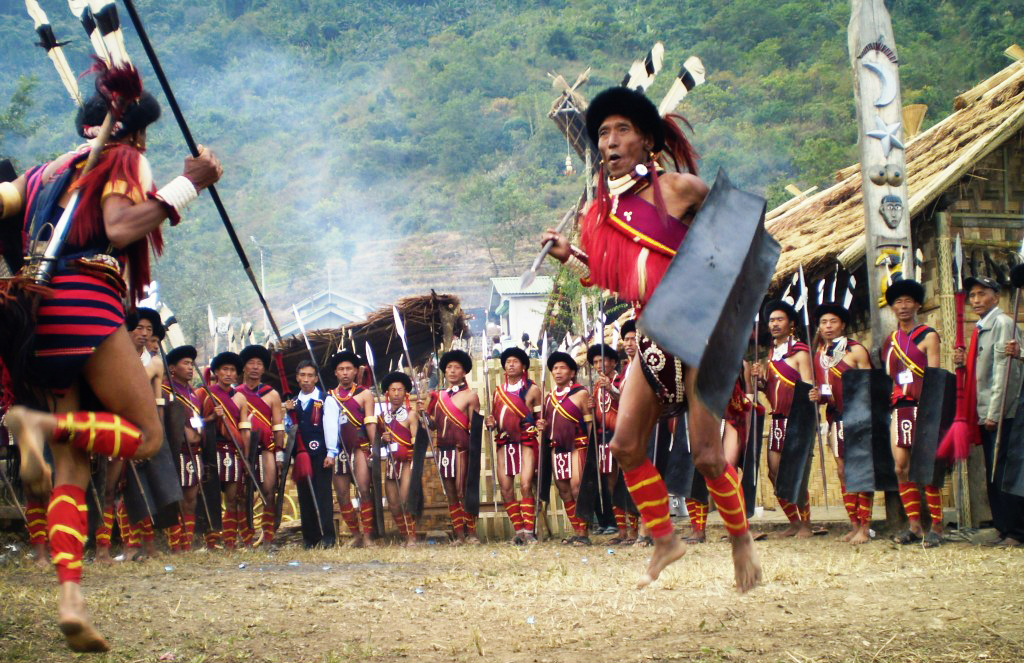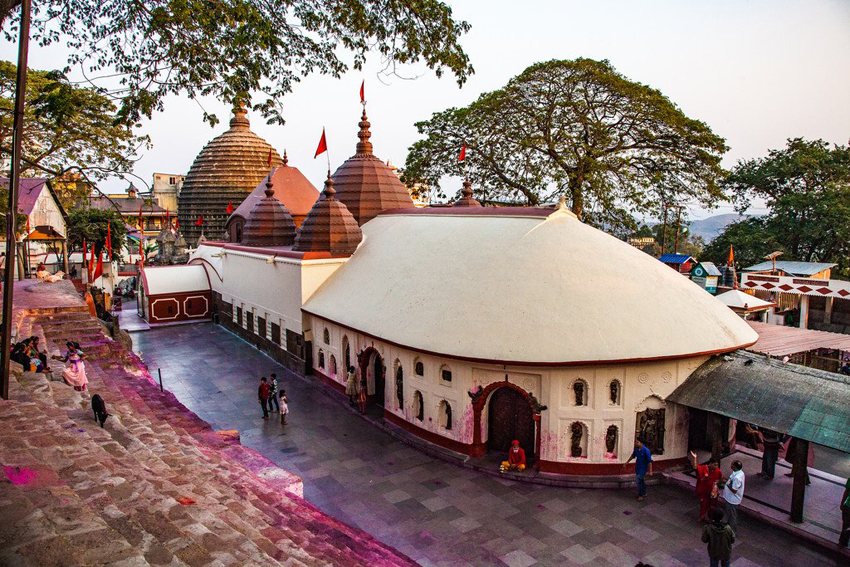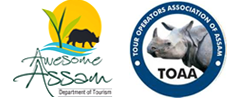Tour Highlight
- Sadhus at Kamakhya Temple during Ambubachi Festival
Pay A Visit To The Kamakhya Temple, Which Is In The Wishlists Of Every Traveller Whoever Come To Guwahati And Seek The Blessings Of Goddess…. A True Celebration Of Womenhood
- Gayan Bayan Dance performed by monks in Majuli
Explore The Traditional Roots Of Assamese Society By Visiting The Vaishnavite Monasteries Of Majuli.
- Elephant Safari in Kaziranga
A Couple Of Nights At Kaziranga National Park Will Give You The Chance To Experience The True Wilderness. The Safari On The Elephant’s Back Coupled With A Jeep Safari Will Surely Surge Your Adrenals.
- Rang Ghar
Visit the erstwhile Capital of Ahom Kingdom in Sivasagar and thereby explore and understand the past glory and the grandeur of the Ahoms.
Itineraries
Day 01: Arrive Guwahati
Meeting upon arrival and transfer to hotel.
Guwahati: Guwahati is Situated on the Southern bank of the mighty River Brahmaputra in Kamrup district of Assam. Previously it was known as Pragjyotishpur (The City of the eastern Light) Guwahati is the fast growing premier city and it is also the gateway to the North Eastern states of India.This city subsequently got the name Guwahati (Guwa-means beetlenut and Hat –means market in Assamese)
Afternoon city tour of Guwahati visiting:
- Kamakhya Temple
Kamakhya Temple: The origin of Kamakhya Temple is pre Aryan situated atop the Nilachal Hill. The formost shrine of Assam, The Kamakhya is an ancient seat of Tantric and shakti Cults of Hinduism. The original temple was destroyed by the invading Muslims in their crusade against Hindu temples and idols in the early part of 16th century. Ultimately it was restored from ruins by King Naranarayan of the Koch dynasty and rebuilt in its present forming 1665 AD.
- Umananda Temple
Umananda Temple: In the vicinity of Guwahati in the middle of the river Brahmaputra on an island hill stands the temple of Shiva ‘Umananda’ (also known as Peacock Island). It is also known as ‘Bhasmachal’ as the rays that emanated from his forehead reduce4d Kamdev to ashes. Within the temple are to be seen the images of Anandi Shiva Linga and a silver ox and Umananda with five faces and ten hands.
Shankardev Kalakshetra: a place where Assamese history and culture is depicted in a sprawling open enclosure. It has a beautiful museum where they preserved the masks (these masks are made in Majuli island), the traditional dresses and jewellery of the entire North East India. A Namghar (Assamese prayer Hall) and an open air theatre has been constructed to perform the plays and other cultural activities during festivals.
- Guwahati War Cemetery
Guwahati War Cemetery: Built and maintained by the Commonwealth War Graves Commission. The cemetery was started during the war when several military hospitals were posted in the area and was originally for burials from these hospitals. There are now 517 causalities buried in this cemetery.
Overnight at hotel.
Day 02: Guwahati / Kaziranga National Park (215 Kms, 5 hrs drive)
Morning after breakfast depart for Kaziranga National Park.
Kaziranga National Park: Kaziranga National Park has become synonymous with successful conservations of Great One Horn Rhinoceros (from the Greek word, “rhino” means nose and “ceros” means horn) / Unicornis (from the Latin word, “uni” means one and “cornis” also means horn) and also a home of may other threatened species including Indian Elephant (Elephant Maximus), Tiger(Panthera tigris), Hoolock Gibbon (Bunipithecus hoolock), Ganges dolphin (Platanista gangetica),Sambar (Cervus unicolor), Barasingha or Swamp Deer (duvauceli), Hog Deer, Indian Muntjac (Muntiacus muntjak), Water Buffalo (Bubalus bubalis) and Gaur (Bos frontalis)etc.
There are also over 500 species of birds have been recorder in the park including 25 specis of globally threatened category. Over and above ther are 21 rare and endangered species. In winter one can observe a large breeding population of Spot Bill Pelicans about one thousand breeding nests are found in a place which has been named as Pelican Colony in the Eastern Range.
Among the reptiles species like Water Monitor Lizard (Varanus salvator), Indian python (Python molurus), Cobra (Naja naja) and the King Cobra are found.
Arrive Kaziranga and check in at the Jungle Resort.
Day 03: Kaziranga National Park
- Elephant Safari
Early morning enjoy the elephant safari in the central (Kohora) range of Kaziranga. Later return to the resort for breakfast.
Afternoon visit the Kaziranga National Orchid and Biodiversity park and witness more that 200 different species of Orchids. Also enjoy the different traditional dance forms and songs along with ethnic foods
- Jeep Safari in Kaziranga
Late afternoon enjoy the exclusive Jeep safari in the western (Bagori) range of Kaziranga.
Overnight at the resort.
Day 04: Kaziranga / Majuli Island (110 Kms, 2 hrs drive and 2 hrs ferry ride)
Morning after breakfast depart for Majuli Island. En route cross the Brahmaputra river by local made ferry.
Majuli Island: The largest inhabitant river line island in the world Majuli has been the hub of Assamese neo-vaishnavite culture and it is the cultural capital and the cradle of Assamese civilization for the past 500 years, by the revered Assamese saint Srimanta Sankardeva and his disciple Madhavdeva. The first vaishnavite monastery was at Belaguri in west Majuli. After that 65 Monasteries (SATRAS) were set up. Today only 22 of the original 65 are survived.
The main tribe of Majuli is Mishing. They comprise of about 47% of the population of Majuli. The term Mishing is also made up of two words- ‘mi’ means people and ‘yassing’ means fine, and that’s why they call themselves fine people. Other comprises Chutias, Deoris, Sonowal Kacharies, Koches, Naths, Kaivarttas, Mattaks, Ahoms, Kalitas, Brahmins etc.
Arrive and check in at traditionally built bamboo hut.
Later explore the traditional roots of Assamese society by visiting the vaishnavite monasteries of Majuli. Visit:
Dakhinpat Satra: Founded by Banamalidev, a supporter of Raasleela, which is now observed as one of the National Festivals of Assam.
Garamurh Satra: This “Satra” was founded by Lakshmikantadeva. During the end of autumn, the traditional the Raasleela is enacted with pomp and celebrations. Ancient weapons called “Bartop” or cannonss are preserved here.
Auniati Satra: Founded by Niranjan Pathakdeva, the satra is famous for the “Paalnaam” and Apsara Dances and also its extensive assortment of ancient Assamese artefacts, utensils, jewellery and handicrafts. It also has a hundred and twenty five disciples and over seven hundred thousand followers worldwide.
- Satriya Dance at Auniati Satra Majuli
Kamalabari Satra: The Kamalabari Satra, founded by Bedulapadma Ata, is a centre of art, cultural, literature and classical studies on the island. Its branch the Uttar Kamalabari Satra has performed cultural programmes of the Satria Art all around the country and abroad.
Shamaguri Satra: The satra is famous for the masks making in India.
Overnight at Bamboo hut.
Day 05: Majuli / Sivasagar (70 Kms, 1 hour drive and 2 hrs ferry ride)
Morning after breakfast depart for Sivasagar. En route again cross the Brahmaputra river by local made ferry.
En route visit the beautiful tea gardens of Assam.
Sivasagar: Situaterd 369 Kms east of Guwahati Sivasagar erstwhile Rangpur is full of historic relice. Bearing testimony of 600 years of Ahom rule. Rangpur became THE 4TH Capital of Ahom Kingdom. The name of the town and the district originated from the Sivsasagar Tank and temples.
Arrive Sibasagar and check in at hotel.
Overnight at hotel.
Day 06: Sivasagar
Morning after breakfast city tour of Sivasagar visiting:
Rang Ghar: An antique two storied imposing structure the Rang Ghar (‘Rang’ means enjoyment ang ‘Ghar’ means house in Assamese language)happened to be the royal sports pavilion (lile wrestling, bird fight, buffalo fight etc) of the Ahom Kings. It was constructed by the 34th Ahom king Pramatta Singha in 1746.
Tolatol Ghar: Originally constructed by the Ahom king Rudra Singha in 1699 the present palace made of bricks and indigenous type of cement constructed by King Rajeswar Singha in 1751-69). Known as the seven storied Kareng Ghar of which four were over ground and remaining three were underground, it was the Capital and the military station of the Ahom kings.
- Sivasagar Tank
Shiva Dole: The Shiva Dole, Vishnu Dole and Devi Dole constructed by second queen of Shiva Singha known as Ambika in 1734. This reputed to be the tallest Shiva Temple in North East India. The Shiva Dole 180 feet in height and 195 feet in diameter caped by seven feet height golden dome.
Sivasagar Tank (Barpukhuri): Constructed by second queen of Shiva Singha queen Ambika in 1734, covers an area of 129 acres. The water level of the tank never changes and remains above the level of the town all the time.
Kareng Ghar (The Gargaon Palace): The original structure had been made of wood and stones. In 1747 King Pramatta Singha constructed the brick wall of about 5 kms.The present surviving Brick palace was rebuilt by king Rajeshwar Singha in 1752.
- Charaideo Maidam
Charaideo Maidam: The tombs of King and Queen at Charaideo Hillock are comparable to the pyramids of Egypt. Charaideo was the first Capital of Ahom Kingdom established by King Sui- Ka- Pha. This is also the sacred burial ground of the kings and the queens of the Ahom Kingdom.
Overnight at hotel.
Day 07: Sivasagar / Jorhat depart (65 Kms, 1 hour drive)
Morning after breakfast in time transfer to Jorhat airport / train station for the onward destination.
Tour ends.
Inclusion and Exclusion
THE PACKAGE COST INCLUDES:
- All transport by a dedicated vehicle
- Accommodation for six nights.
- Daily breakfast at hotel.
- One Elephant safari and one jeep safari in Kaziranga National Park with park entrances.
- Ferry charges to and from Majuli island
- All parking, toll charges, driver’s allowances etc.
- 5 % GST as applicable
THE PACKAGE COST DOES NOT INCLUDE:
- Any meals other than mentioned above.
- Entrances to the monuments, parks other than mentioned above.
- Charges of the accompanying guide or local guide (if required)
- Any expenses occur due to natural calamities or which are not mentioned in the cost inclusions
- Any other expenses of personal nature i.e camera, laundry, telephone, any type of insurances, tips, portages etc.




